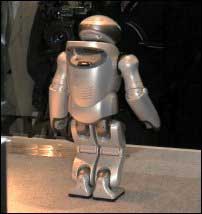For the first time, a robot powered by living cells, developed by Dr. Klause Peter Johner from the University of Southampton, has been unveiled to the public. These are light-sensitive mold cells specifically cultivated for this purpose.
Dr. Johner cultivated star-shaped molds with six arms, each arm attached to a leg of the robot. This is a testing apparatus to evaluate the robot’s functionality.
When white light hits a specific area of these unicellular molds, the mold begins to vibrate and change in thickness. These vibration frequencies are transmitted to a computer, which then sends signals to move the robot’s legs. By directing light to different areas of the mold, the legs will move. If the light is continuously directed in this manner, the robot will be able to walk.
 |
Robot Qrio. Illustrative image from a foreign website. |
British scientists collaborated with researchers from Kobe University in Japan to create this robot, focusing on methods of using living cells in robotics.
Dr. Johner aims to enhance robot control using specific molecules from living cells, rather than intact cells.
According to scientists, the experience of applying biological cells in electronic devices has been around for a long time, but only in sensory components. Dr. Johner’s work is the first demonstration of using cells to monitor the robot’s activities. Notably, these cells can self-repair and restructure, a capability that conventional technology cannot achieve.
By utilizing biological cells, the robot can partially adapt while moving, such as navigating obstacles and maneuvering through complex terrains. Consequently, robots equipped with biological functions will be able to respond to unexpected situations arising in their environment.
Dr. Johner states that the application of biological cells in robot research is just beginning.




















































